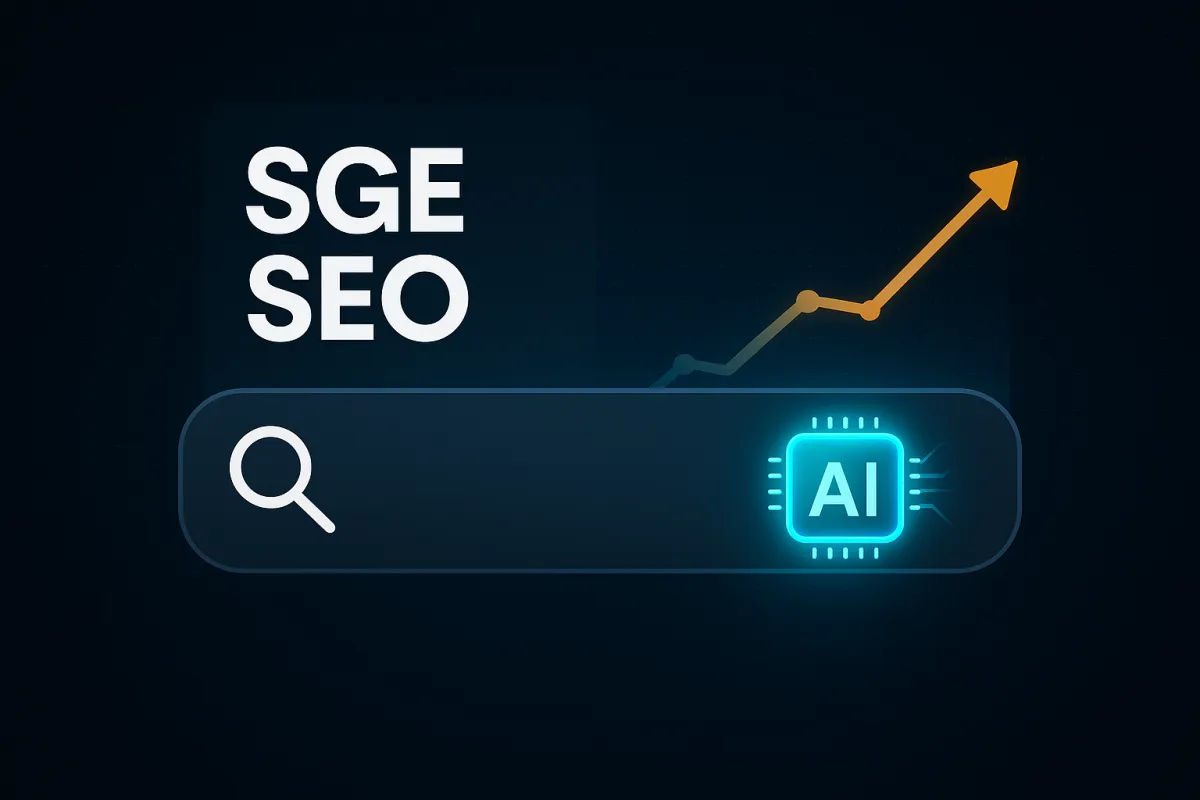Solo SEO in the SGE Era: How One-Person Teams Can Optimize for Google’s AI Search (2025)
A 5-step SGE SEO strategy for one-person content teams, with solo-friendly, low-budget tactics

Why this matters now
Google’s Search Generative Experience (SGE) places AI summaries above traditional results.
Those summaries often cite only a few sources, which means fewer chances to earn the click.
Independent tests have found that SGE overviews typically show three to five sources, and in a small share of cases there are no external links at all.
See coverage and data in Search Engine Journal and Search Engine Land for specifics:
The key takeaway for solo creators in 2025: clear, structured, experience-driven content still wins.
The job is to make your pages easy for AI to quote and for humans to act on.
The 5-step SGE strategy for solo creators
1) Pick “SGE win zones” before you write
You will not be cited on every query. Focus where you can realistically be one of the three to five sources that appear.
- Start with your data: In Google Search Console, find queries with impressions but weak or falling CTR. Those are “near misses” that likely already trigger AI summaries.
- Prioritize long-tail questions: Build pages around specific “what,” “how,” and “should” questions. These align tightly with how SGE composes answers.
- Skip dead ends: If SGE resolves the query without links or it always surfaces the same big brands, invest elsewhere.
- Fast brief workflow: Use this outline method to scope intent quickly: SEO Content Briefs in 2025: Solo Founder’s 30-Minute Intent-First Workflow.
Decision rule: If you cannot be one of the clearest, most scannable explanations for a query, choose a narrower angle you can own.
2) Structure pages for generative answers, not just blue links
SGE prefers content it can lift cleanly and cite.
- Lead with a definition: If your topic supports a “What is” angle, include a single-paragraph definition near the top.
- Use Q and A headings: Add H2 or H3 questions and answer in two to four sentences. Expand further down the page.
- Favor steps and short lists: Provide compact procedures and checklists that a model can quote without heavy editing.
- Add basic schema: FAQ, HowTo, and Person schema make your intent and authorship explicit. See this practical primer from Search Engine Land: Preparing for Google SGE.
Solo tip: Think “answer first, depth second.” Give the concise answer high on the page, then elaborate for users who keep reading.
3) Make E-E-A-T unmistakable, and make it personal
SGE selection criteria do not perfectly mirror the top ten organic results. It often favors sources that look credible and useful at a glance.
- Real author box: Name, role, years of hands-on experience, and a line on what you actually do in the field.
- Write from experience: Include what you tried, what worked, and what failed. One paragraph of genuine specifics is stronger than five generic tips.
- Show trust signals: Link to primary data or reputable reports, publish clear editorial standards and date stamps, and keep visible policies.
- Edit carefully: Do not post raw AI drafts. Quality raters flag thin or low-effort pages. See Search Engine Land on rater guidance and AI content context: Quality raters and AI content.
Solo tip: Add a “How I tested this” box with bullets on your sample size, tools, and timeframe. It reads as evidence, not opinion.
4) Ship the smallest viable update, then add depth
You do not need a full site overhaul. Start with pages that already earn impressions.
One-day upgrades:
- Add a crisp definition and a short “How it works” block.
- Add a numbered checklist of the key steps.
- Add three to six PAA-style Q and A entries that mirror real queries.
- Add FAQ, HowTo, and Person schema, plus your author box.
Next pass:
- Add depth sections users actually need: caveats, costs, timelines, tool comparisons, or templates.
- Create one supporting page that answers a tightly related sub-question and interlink the pair.
Real-world results vary, but there are documented cases where SGE-focused content updates helped sites swing from projected losses to growth. See Search Engine Land’s case write-ups: SGE recovery case studies.
Solo tip: Treat every update like a product release. Keep a changelog, wait two to four weeks, review GSC, then iterate.
5) Measure SGE impact and adjust on a schedule
- Watch impressions and CTR: If impressions are steady but clicks fall, your answer likely satisfies the query without earning the click. Tighten your lead answer and target adjacent questions.
- Inspect who SGE cites: Manually check the overview for your queries. Study the cited pages’ layout and copy patterns, then adapt what fits your brand.
- Review monthly: Small improvements, shipped often, beat big annual rewrites. For adaptation guidance, see SEJ’s overview: How to adapt SEO for SGE.
Solo tip: Add a recurring calendar block labeled “SGE review.” In that block, open GSC, check your top ten queries by impressions, and perform one manual SGE spot check per query.
Solo-friendly on-page checklist
Use this when you update or publish:
- One-paragraph definition near the top
- Two to four sentence answer under a clear H2
- Three to six PAA-style Q and A entries
- Short numbered “How to” section or key steps
- FAQ, HowTo, and Person schema added
- Real author box with credentials and proof of work
- One to two trusted external sources cited
- One to two internal links to deeper pages you own
Mini-FAQ for solo creators
What is Google SGE?
An AI-generated summary at the top of search results that often reduces the need for additional clicks. See SEJ’s coverage: SGE impact by vertical.
Do I need to rank number one to appear in SGE?
No. SGE selection does not always align with traditional rankings. Structure and clarity matter.
Is SGE all doom for small sites?
No. Outcomes are mixed. Focused updates aimed at SGE factors have coincided with recoveries in documented cases. See SEL’s case studies: SGE recovery.
What if clients start asking about “GEO packages”?
Point them to a simple, transparent plan first: Generative Engine Optimization, the new SEO people are buying in 2025.
Bottom line
SGE shrinks the list of sources per query.
Solo creators can still compete by doing three things consistently:
- Structure pages so AI can quote them
- Make expertise obvious and personal, and iterate based on data.
- Start with the pages that already get impressions
Ship the smallest viable update, and improve them on a monthly cadence. The problem is rarely that you are small. The problem is usually that the answer is not clear enough or early enough, to be chosen.
References and further reading
- Search Engine Journal, SGE’s traffic impact by vertical
- Search Engine Land, How Google SGE impacts traffic and recovery case studies
- Search Engine Land, Preparing for Google SGE
- Search Engine Land, Quality raters and AI content context





